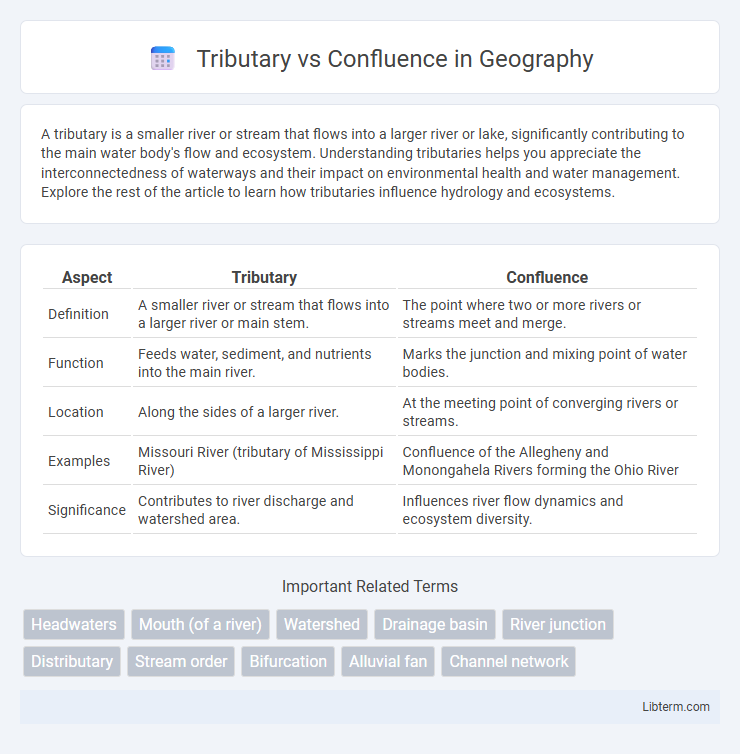A tributary is a smaller river or stream that flows into a larger river or lake, significantly contributing to the main water body's flow and ecosystem. Understanding tributaries helps you appreciate the interconnectedness of waterways and their impact on environmental health and water management. Explore the rest of the article to learn how tributaries influence hydrology and ecosystems.
Table of Comparison
| Aspect | Tributary | Confluence |
|---|---|---|
| Definition | A smaller river or stream that flows into a larger river or main stem. | The point where two or more rivers or streams meet and merge. |
| Function | Feeds water, sediment, and nutrients into the main river. | Marks the junction and mixing point of water bodies. |
| Location | Along the sides of a larger river. | At the meeting point of converging rivers or streams. |
| Examples | Missouri River (tributary of Mississippi River) | Confluence of the Allegheny and Monongahela Rivers forming the Ohio River |
| Significance | Contributes to river discharge and watershed area. | Influences river flow dynamics and ecosystem diversity. |
Introduction to Tributaries and Confluences
Tributaries are smaller streams or rivers that flow into a larger river, contributing additional water volume and sediment to the main channel. Confluences occur where two or more water bodies join, often creating distinct changes in flow dynamics, sediment transport, and ecological habitats. Understanding the interaction between tributaries and confluences is essential for river basin management, flood prediction, and aquatic ecosystem conservation.
Defining Tributary: Meaning and Characteristics
A tributary is a smaller stream or river that flows into a larger one, contributing to its volume and watershed. Key characteristics include its role in drainage networks, lack of direct access to the sea, and influence on sediment transport and nutrient flow. Unlike a confluence, which is the point where two or more bodies of water meet, a tributary specifically denotes the subsidiary waterway feeding into the main river.
Understanding Confluence: Meaning and Features
A confluence is the point where two or more rivers or streams meet and merge into a single channel, often resulting in a significant increase in water volume and flow. Key features of a confluence include the mixing of distinct water bodies, variations in sediment load, and potential changes in water quality and ecosystem dynamics. Understanding confluences is crucial for river management, flood control, and studying aquatic habitats.
Key Differences Between Tributary and Confluence
A tributary is a smaller stream or river that flows into a larger one, contributing additional water volume, while a confluence is the point where two or more rivers or streams meet and merge together. Tributaries generally increase the flow and watershed area of the main river, whereas confluences are significant for hydrological dynamics and sediment mixing at the junction. Understanding the distinction between these terms is crucial for river basin management, flood control, and ecological studies.
Role of Tributaries in River Systems
Tributaries play a crucial role in river systems by feeding smaller streams and rivers into main rivers, increasing water volume and influencing flow dynamics. They contribute to sediment transport and nutrient distribution, which supports diverse aquatic habitats and maintains ecological balance. Tributaries also affect flood regulation and water quality, making them essential components of watershed management.
Importance of Confluences in Hydrology
Confluences, where two or more rivers meet, play a critical role in hydrology by influencing water flow, sediment transport, and nutrient distribution within a watershed. These junctions are essential for maintaining aquatic biodiversity, regulating flood dynamics, and supporting the ecological health of river systems. Understanding confluences helps predict water quality changes and manage riverine habitats more effectively.
Geographic Examples of Tributaries and Confluences
The Amazon River exemplifies a colossal confluence where the Rio Negro and Solimoes merge, creating one of the world's largest river junctions. Tributaries like the Missouri River feed into the Mississippi River, showcasing a significant tributary system crucial for North America's drainage basin. In Asia, the Ganges-Brahmaputra confluence forms a vital geographic and cultural nexus, while tributaries such as the Yamuna enrich the Ganges with additional water volume and sediment.
Ecological Impact: Tributaries vs Confluences
Tributaries contribute nutrients and sediments that enhance biodiversity by creating diverse aquatic habitats, while confluences are dynamic zones where water chemistry, flow, and sediment load mix, often leading to increased species richness and ecological productivity. The mixing of waters at confluences can alter temperature and oxygen levels, impacting fish migration and spawning patterns crucial for ecosystem health. Both tributaries and confluences function as vital ecological interfaces that support nutrient cycling and habitat connectivity in riverine systems.
Human Settlements Near Tributaries and Confluences
Human settlements near tributaries often benefit from abundant freshwater resources, fertile soil due to sediment deposits, and easier access to trade routes, promoting agriculture and economic development. Confluences, where two or more rivers meet, frequently host larger urban centers because the merging waterways provide enhanced transportation networks, increased water supply, and strategic advantages for commerce. Both tributaries and confluences influence settlement patterns by shaping local ecosystems, enabling diverse livelihoods, and serving as critical nodes for cultural and economic exchange.
Conclusion: Tributary or Confluence—Which Matters More?
Tributaries play a crucial role in expanding a river's volume and biodiversity by feeding smaller streams into larger waterways, while confluences represent the dynamic points where these waters merge, impacting river flow and ecosystem connectivity. Understanding the importance of tributaries is essential for managing water resources and preserving habitats, but confluences are key for studying sediment transport, water quality, and ecological interactions. Both tributaries and confluences matter significantly, with tributaries sustaining the river system and confluences shaping its structure and function.
Tributary Infographic

 libterm.com
libterm.com